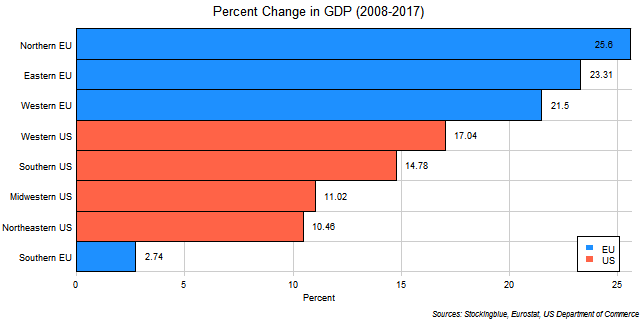
The chart above shows change in GDP over the last ten years in EU and US regions. Although the EU has three of the fastest growing regions, it also has one region where there was almost no growth at all over the past ten years. Whereas in the US, growth was weaker than most EU regions but more equally spread out among them.
Findings
- The difference between the region with the greatest growth in GDP, the Northern EU, and the region with the least, the Southern EU, is 22.86 percentage points.
- The Northern EU has 9.36 times the economic growth that the Southern EU does in the past decade.
Caveats
- All figures are rounded to the nearest hundredth.
- EU and US data come from different sources.
- The Northern EU consists of Sweden, Denmark, and Finland.
- The Eastern EU consists of Poland, Czech Republic, Romania, Hungary, Slovakia, Bulgaria, Croatia, Slovenia, Lithuania, Latvia, and Estonia.
- The Western EU consists of Germany, United Kingdom, France, Netherlands, Belgium, Austria, Ireland, and Luxembourg.
- The Western US consists of California, Washington, Colorado, Arizona, Oregon, Utah, Nevada, New Mexico, Hawaii, Idaho, Alaska, Montana, and Wyoming.
- The Southern US consists of Texas, Florida, Georgia, North Carolina, Virginia, Tennessee, Louisiana, South Carolina, Alabama, Kentucky, Oklahoma, Arkansas, Mississippi, and West Virginia.
- The Midwestern US consists of Illinois, Ohio, Michigan, Indiana, Minnesota, Wisconsin, Missouri, Iowa, Kansas, Nebraska, North Dakota, and South Dakota.
- The Northeastern US consists of New York, Pennsylvania, New Jersey, Massachusetts, Maryland, Connecticut, New Hampshire, Delaware, Maine, Rhode Island, and Vermont.
- The Southern EU consists of Italy, Spain, Portugal, Greece, Cyprus, and Malta.
Details
It is pretty clear than whether one is looking at individual states or regions, the EU has had a better growth story over the past ten years, however, one would have seen more growth by far in any US region than the Southern EU. So although the EU as a whole has done better, it still has issues with large differences in economic growth within the Union.
The European Union as a whole has 17.31 percent growth over the same ten year period ranking it under the Western EU and above the Western US (and above all US regions). The United States as a whole has 13.56 percent growth over the same ten year period ranking it just under the Southern US and above the Midwestern US (and below all EU regions save for one).
Sources
Eurostat. 2018. "Eurostat - Tables, Graphs and Maps Interface." Accessed June 26, 2018. http://ec.europa.eu/eurostat/tgm/table.do?tab=table&init=1&language=en&pcode=tec00001&plugin=1.
US Department of Commerce. 2018. "US Bureau of Economic Analysis." Accessed June 26, 2018. https://bea.gov/itable/iTable.cfm?ReqID=70&step=1#reqid=70&step=10&isuri=1&7003=1000&7035=-1&7004=naics&7005=1&7006=01000,02000,04000,05000,06000,08000,09000,10000,11000,12000,13000,15000,16000,17000,18000,19000,20000,21000,22000,23000,24000,25000,26000,27000,28000,29000,30000,31000,32000,33000,34000,35000,36000,37000,38000,39000,40000,41000,42000,44000,45000,46000,47000,48000,49000,50000,51000,53000,54000,55000,56000&7036=-1&7001=11000&7002=1&7090=70&7007=2017,2016,2015,2014,2013,2012,2011,2010,2009,2008,2007,2006&7093=levels.